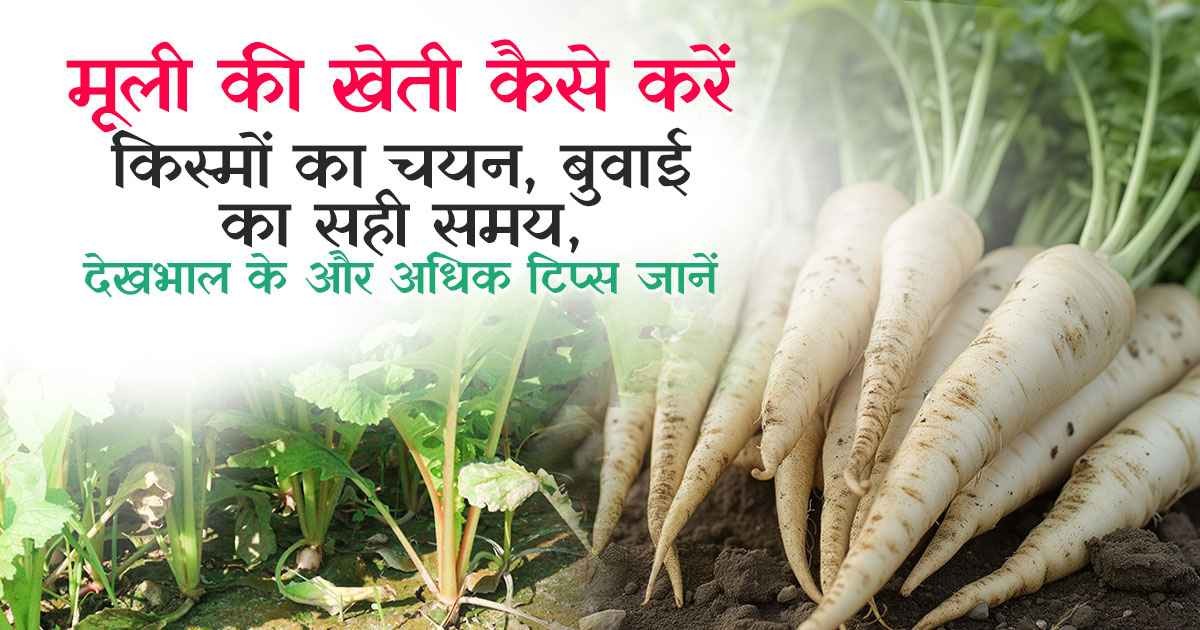By khetivyapar
Posted: 29 Aug, 2024 12:00 PM IST Updated Fri, 30 Aug 2024 12:15 PM IST
Radish is a quick-growing crop that can be easily cultivated during the Zaid season. The roots of radish are rich in vitamins and minerals. It is grown in both summer and winter seasons in the dry temperate and mountainous regions of the country. Radish farming is widespread across India, with major cultivation in West Bengal, Gujarat, Himachal Pradesh, Bihar, Punjab, Assam, Haryana, and Uttar Pradesh.
Radish Cultivation:
Radish is used as a salad and vegetable, known for its pungent taste. It is also used in breakfast dishes like parathas, and the leaves are cooked as a vegetable. Radish is a good source of vitamin C and minerals. It is recommended for liver and jaundice patients due to its health benefits.
Climate, Soil, and Land Preparation for Radish Cultivation:
Cool climate is ideal for radish cultivation, with the best temperature range being 10-15°C. Radish can grow in all types of soil, but sandy loam soil is most suitable. For radish cultivation, deep plowing with a soil-turning plow should be followed by 2-3 rounds of cultivation using a cultivator to level the land before sowing.
Improved Varieties of Radish:
- Pusa Himani: Developed in 1970, this variety has roots about 30-35 cm long, thick, pungent, white with green tops, and a mildly sweet flavor. It matures in 50-60 days and is ready for harvest from December to February. The average yield is 32.5 tons per hectare.
- Pusa Reshmi: This variety is grown throughout India, with roots around 30-35 cm long, medium thickness, and white with a pungent flavor. It matures in approximately 55-60 days with an average yield of 32.5 tons per hectare.
- Pusa Chetki: Developed in 1988, this variety is suitable for summer cropping across India. It has soft, tender roots about 15-22 cm long, with a mild pungency and matures in 40-45 days. The average yield is 25 tons per hectare.
Fertilizers and Nutrients for Radish Cultivation:
Radish cultivation requires approximately 100-150 quintals of organic manure or compost, 100 kg of nitrogen, 50 kg of phosphorus, and 100 kg of potash per hectare. Organic manure, phosphorus, and potash should be applied during land preparation, while nitrogen should be applied in two stages, 15 and 30 days after sowing.
Optimal Sowing Time for Radish: Radish can be cultivated throughout the year, but sowing between September and January results in higher yields.
Sowing Methods for Radish:
- Row Method: Prepare rows with a spacing of about 30 cm. Sow the seeds at a depth of 3 cm. Once the seeds germinate and the plants have two leaves, thin them out to maintain a spacing of 10-12 cm between plants.
- Ridge Method: In this method, 15-20 cm high ridges are made with a spacing of 30 cm. Seeds are sown at a depth of 3-4 cm. After germination, thin out the plants to maintain a spacing of 10-12 cm. This method promotes better root development, resulting in tender radishes.
Irrigation and Drainage in Radish Cultivation: If the soil lacks moisture during sowing, a light irrigation is necessary. Irrigation is not required during the rainy season, but proper drainage should be ensured. In the summer, the crop needs irrigation every 3-4 days, while in the winter, it should be irrigated every 8-10 days. Irrigation on ridges should be done on one side only to maintain moisture on the ridge.
Common Pests and Diseases in Radish:
- Aphid Infestation: Aphids are small white insects that suck the sap from leaves, causing them to curl and making the crop unsellable. Spraying Malathion (2 ml per liter of water) or a 4% neem oil solution mixed with a sticker like Chikoo or Sandovit is effective in controlling this pest.
- Hairy Caterpillar: This caterpillar is brown and hairy, feeding on leaves in large numbers. Control by applying Malathion dust (10%) at a rate of 20-22 kg per hectare in the morning.
- Alternaria Blight: This disease is more common between January and March. Small dark spots appear on leaves, and oval to elongated spots develop on the roots. To control, treat seeds with Captan (2.5 gm per kg of seeds) and remove and burn affected leaves.
Harvesting and Yield: Radish roots should be harvested when they are fully developed but still tender. The yield depends on the variety, soil fertility, and fertilizer use. On average, radish yields around 200 quintals per hectare.
